 |  |
By Greg Niemann
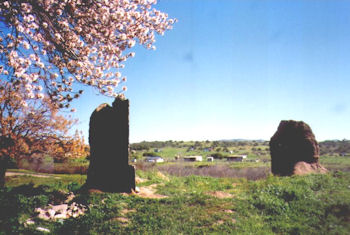
It was back in 1998, and my timing for an adventure into Baja California’s northernmost mountains could have hardly been worse. The punch of violent rainstorms spawned by the warm El Niño current had just left thousands of nearby Tijuana residents homeless. Many people lost their lives in onslaughts of mud and water during the seemingly endless February rains.
March 3 dawned bright and sunny and with six warm days in a row the horrors of the rains were fading with the sunshine. The sirens of the Sierra Juarez screamed at me.
I loaded up my 2-wheel drive Ford Explorer, pored over several maps, and headed off to visit the old mining town of Real del Castillo.
The muddy, potholed streets of Ensenada served as a premonition I chose to ignore. After all, adventure travel requires optimism. In some of us, sometimes, that optimism spills over and becomes downright foolhardiness. Call it whatever, I pressed on.
Highway 3 winds up out of the Ensenada suburbs into the mountains. Potholes, which are always a Baja hazard, were of legendary size and number all along the 160-mile highway to San Felipe and the gulf. Mud cascaded onto the highway, and in parts the macadam road had actually been washed away, rendering only a single lane.
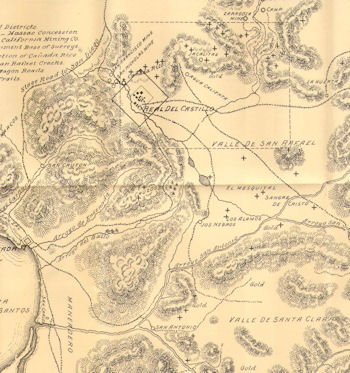
After 25 miles, the winding road descends into a broad fertile valley. At just over 2,000 foot elevation, the 18-mile long by 6-mile wide valley is called the Valle de San Rafael, the Valle del Real del Castillo, or the Valle de Ojos Negros, take your pick.
Here fertile green farms and pastoral ranches checker the landscape, broken only by the proverbial Baja fence of three strands of barbed wire wrapped around intermittent mesquite branches. The cows here, unlike their scrawny kin in the wilds to the south, are stocky and appeared well-fed. In fact cattle had been grazing there since 1798 when padres from the Santo Tomas mission brought 800 head to graze, making the valley a major mission subsistence area.
I stopped at a grocery store in the village of Ojos Negros to confirm directions to Real del Castillo, once the most important town and for 10 years the capital of Baja California.
Most people had never heard of the place, but after gold was discovered there in 1870 by Manuel del Castillo, a mining boom was set off creating a bustling settlement of about 1,500 people within two years. It became so important that by 1872 it had replaced Santo Tomás as the capital of the Baja California Norte district and remained so until 1882 when the capital was removed to Ensenada.
A later (1889) gold boom a few miles to the south around El Alamo prompted my great-grandfather Bascom A. Stephens to pen the book “Gold Fields of Lower California.” Old maps in his book show the major route from San Diego going through Tijuana, south to the Guadalupe valley and then up through Real del Castillo.
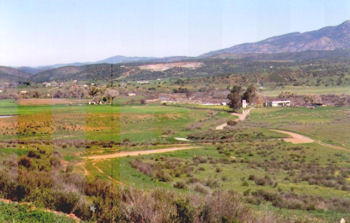
No current map or guidebook shows a road going through from Guadalupe to Real del Castillo even though I knew a trail had to go up through a canyon nearby.
The previous summer a rancher on the northwest Guadalupe side confirmed that his canyon was indeed the one the miners used over 120 years previous. That day I hiked partway up to a tumbling waterfall with a cool, clear pool, and to the “Agua Caliente” that gave the canyon its name. I enjoyed immersing myself in the steaming small pool of natural hot water, imagining dusty, tired argonauts heading south with big dreams. Did they stop to enjoy the thermal water? Or did the dream of a bonanza preclude such foolishness?
Convinced of the route, I planned to see this former boomtown at the top of the canyon for myself.
So the next summer at the Ojos Negros abarrotes (grocery store) I encountered an elderly woman who knew the area’s history well. She lamented that most of the Real del Castillo buildings had fallen down through neglect and then pointed out the road that leads north along the valley’s western flanks to the old mining capital.

The only paved road in the valley is Highway 3 from Ensenada to San Felipe. The rest are dirt, flat farm roads which after heavy storms became mud, with occasional bogs and quagmires.
Thus the entire eight-mile trip out to Real del Castillo became an obstacle course. Many pools had to be skirted, detoured around or slowly driven through. The rains had left rivulets across the road so that even seemingly fast flat sections required utmost caution.
At one section a small crew was shoveling dirt into an especially nasty hole where half the road had eroded away. It seemed like trying to win a war with a pea shooter to me. One worker confirmed that Real del Castillo was only "cinco minutos" away, just over the crest ahead where the valley ended.
From the crest I could see a meandering river below and on its banks, a flat townsite with just a few buildings remaining. I pulled out an old photo of the town and matched it up with the distant hills and mountains. Yup, this is it all right.
Ahead I initially balked at fording the river, now swollen from the rains. After visually sizing up the water’s depth, I quickly drove across, reaching the town’s center on a flat plateau.
A couple old buildings remained. I walked to one with signs indicating it was a museum, but it was empty and showed no signs of showcasing anything but dust. About 100 yards away, across the flat barren field, was a large old building with a tin roof. But what caught my eye was a huge sign above the door that in bright orange lettering said "Saloon."
Thinking it to be a business establishment, I approached and halloowed my presence. I could hear soft, gentle music in the background, a contrast to the fast beat tempo of the “Ranchero” music so often heard in rural Baja. A petite and pretty Mexican woman of indeterminate age came to the door and at her heels a charming little girl about six years old.
"No, it’s not a saloon," she said. They just liked the sign.
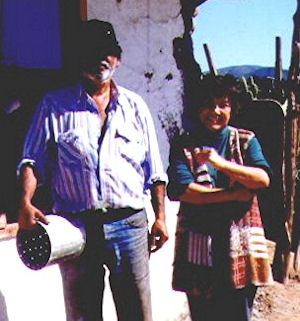
Yes, the now bulging stream that now wound around her house and descended into the nearby canyon behind was the old miners’ road. As we were talking, an older looking man with a white beard strode up to the house from across the field.
"Mi esposo," she said, telling me it was her husband who was approaching. As he neared I could see he was younger than his white beard at first indicated. “Me llamo Enrique Lenchione,” he said in introduction. "Y esta es mi esposa Rachela. Y nuestra hija, Rachelita Sesena." he added proudly indicating their daughter. "Con mucho gusto," I politely nodded, and I told them I was a writer interested in the history of Real del Castillo.
They seemed proud to be sitting on a piece of such significant terrain, the closest building to the head of the canyon from which the miners had emerged. They had their own stories, how half of their house was a holdover from the 1870s.
Rachela went in and brought out a treasure she’d found behind the house, an 1872 American dime, again confirming that Americans came this way back then. Rachela also presented an article in an American newsletter apparently written during the 1970s about Real del Castillo. It was her only copy and I was wishing I had a portable fax machine, but returned it to her after I read it, and translated much of it for her.
Then she brought out a large sheet of parchment paper upon which was printed a copy of the town’s incorporation in 1870. Titled “Acta De Instalacion del Pueblo y Real del Castillo,” it states how the dignitaries got together on October 2, 1870 and set out to establish the town.
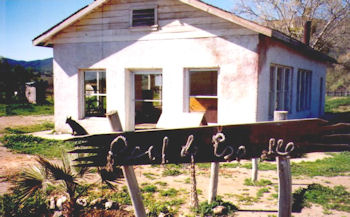
"Es un regalo," she offered, explaining the copy was a gift for me. I gratefully accepted and remembered to give them a few items before leaving.
The importance of the old mining town of Real del Castillo has dwindled for the past 120 plus years and I realized that the one-time capital had dissolved to an almost barren plateau.
Visions of those ambitious travelers who established the town, pumped up with the optimism of striking it rich, are omnipresent. To tread the town is to feel their presence. One of them even lost a new dime that would link the place in history to the present.
Even without that history, friendly people like the Lenchione family make heading into rural Baja, specifically a small village like Real del Castillo, a warm place to visit.
About Greg
Greg Niemann is the author of Baja Fever, Baja Legends, Palm Springs Legends, Las Vegas Legends, and Big Brown: The Untold Story of UPS. Visit his website. Writer B.A. Stephens is his father’s maternal grandfather.

Just all around fantastic people, can't say enough good. Very professional, very helpful, great...

I just used them again Jun 16-19. The best coverage at a great price! I have used Baja Bound...

I recently purchased insurance for my trip with Baja Bound because of their reputation and reviews....